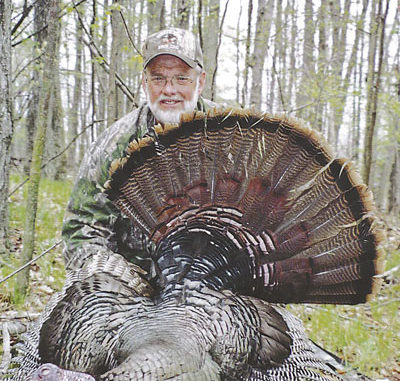
Having trouble taking late-season toms? These tricks that work elsewhere also work in North Carolina.
Hunting wild turkeys is a lot like the late rounds of a boxing match.
Successful pugilists must study their opponents, learn their tendencies and weaknesses, then get in position to deliver a knockout blow.
The same approach applies to hunting a wild gobbler. And during a match of wits with a wily tom, more often than not, hunters have to adjust strategies.
In other words, there’s a lot more to turkey hunting than meets the eye, and adapting to changing conditions and situations may be the most important characteristic a turkey hunter can possess.
Getting the drop on a late-season tom doesn’t have to be difficult, if you take time to learn from successful hunters.
Jack Rich of Graham makes an annual spring trip to Tioga County, N.Y., to hunt wild turkeys at Turkey Trot Acres, one of the premier turkey hunting lodges in the northeast. What he’s learned from the lodge’s guides, he’s transferred back to North Carolina.
“I’ve hunted up there 10 or 11 years now in a row,” said Rich, the retired former owner of BucknBass Sportsman’s Shop in Graham. “I’m not a great turkey hunter by any stretch of the imagination, but I’ve been lucky enough to hunt with some of the top guides in the country, and I’ve learned a lot just by being with them. I usually kill two turkeys each spring up there, so I’ve probably killed 20 or 22 New York birds in the last 10 years.”
One of the most successful tricks Rich has learned involves early morning calling around fields without having heard or seen any gobblers that day.
“One of the top guides I’ve been up there is Steve Lacorchick,” said Rich, who described one of Lacorchick’s favorite tactics as setting up a blind at a field’s edge, then going to each corner of the field while his client remains in the blind.
“You can only hunt turkeys in New York from daylight until noon,” Rich said, “so Lacorchick would have already scouted fields he knew turkeys were using so we could hunt them in the mornings.
“After I got in the blind, Steve went to each corner of the field — and it didn’t matter if the corners were 200 yards from the blind — and he’d use a big boat-paddle box call to make ‘cut’ calls as loud as he could — three, four or five loud cuts. Then he’d walk to the next corner and cut until he’d done this at each corner of the field. Then he’d walk back and get in the blind with me.”
According to Rich, a flock of hens would often show up with a gobbler in tow, but often an hour or more after the guide’s calls had ended.
“You can’t do soft yelps at turkeys that may be hundreds of yards away, but the boat-paddle calls are really loud,” Rich said. “It just takes patience to wait out the turkeys.
“I don’t know why guys (in North Carolina) don’t use boat-paddle calls this way. It’s a very effective way to hunt.”
Rich also learned a trick from another guide, Ed Ripic, that helped bag a reluctant gobbler.
“We were at a field one morning when Ed spotted a gobbler that had left our field and gone into some woods,” Rich said.
Knowing the terrain, Ripic figured the turkey was headed for an field on the other side of the woods, so they hurried to outflank the bird.
“Sure enough, he came out about 150 yards from us,” Rich said. “We backed up against a big hemlock tree with me on the side facing the turkey and Ed behind me.”
The second field was an old pasture, overgrown with weeds and small pines.
Ripic made several yelp calls, which the gobbler answered, but the bird wouldn’t come across the field, apparently “hung up.”
“Ed whispered to me that he was gonna ‘fan’ the turkey,” Rich said. “I didn’t know what he meant, but I found out pretty soon.”
In his jacket, Ripic carries a compressed gobbler’s tail feathers that, when opened, are in full-fan display.
“Ed reached around the tree and held the fan over my head and slowly moved it back and forth, like a gobbler in full strut, turning it from side to side,” Rich said. “I wouldn’t have believed it if I hadn’t seen it, but that gobbler walked across that field straight to my gun. I’ve also seen Ed ‘fan’ gobblers to other hunters, including crawling out into a field on his belly and ‘fanning’ gobblers closer.”
Rich cautioned anyone who wants to try this technique to make sure other hunters won’t be stalking your fan.
Most serious turkey hunters know about the technique of mimicking gobbler fights to lure longbeards. But Rich said Ripic sometimes uses fighting hens to entice gobblers.
“I’ve seen Ed make this work three times,” Rich said. “Once, he and I were on the edge at a field on top of a mountain like you’d find around North Wilkesboro. The field was probably 600 yards long, and we spotted a gobbler and three hens about mid-field from us.”
They sneaked close to the field’s edge, then eased up to a fenceline just below a ridge running through the field.
“We couldn’t see the birds that were on the other side of the rise, so we got ready, and Ed yelped and purred, but the hens pulling the gobbler would only feed about 70 yards from where we were and wouldn’t come any closer.”
Ripic told Rich he was going to mimic hens fighting to see if that would draw the hens closer, perhaps pulling the gobbler within gun range.
“He used a diaphragm and a slate call at the same time, making hard cuts on the two calls in different tones, sounding like two hens fighting,” Rich said. “He’d also turn his head in different directions while he was using the mouth call and the slate call.”
Almost immediately, a hen came running, with the big gobbler waddling behind her.
“I killed him at 20 yards,” Rich said. “This tactic has worked for me twice out of 10 times we’ve used it, so I’d say that’s still a pretty good percentage.”
Because wild turkeys are so attuned to their surroundings, some hunters believe pop-up camouflage blinds placed in open fields make the birds wary.
However, guide Billy Newman of Virginia taught Jack Rich that isn’t necessarily so. In fact, Newman proved to Rich that turkeys pay no little or no attention to pop-up blinds in open fields.
“You might have a really hot field that turkeys are using, and (the field) is so big the turkeys feel safer out in it, so it’s hard to call them near the edges,” said Rich, who related that Newman believes wild birds are more comfortable out in the open where foxes, bobcats or coyotes can’t put the sneak on them without being seen.
“He’d just set up his pop-up blind in the middle of the field and put a spread of decoys in front,” Rich said. “Billy said wild turkeys are used to seeing other birds out in big fields. One time he said he even had a gobbler in full strut brush up against his blind as it was headed for the decoys.”
That bird never made it to the false hens and jake.

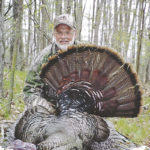
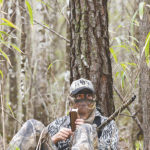
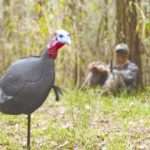
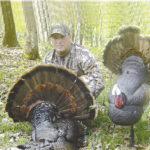



Be the first to comment